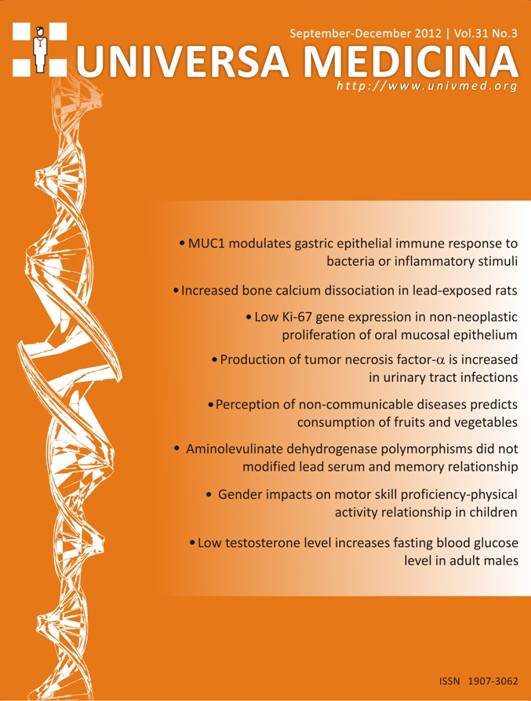Gender impacts on motor skill proficiency-physical activity relationship in children
Main Article Content
Abstract
Article Details
Issue
Section
The journal allows the authors to hold the copyright without restrictions and allow the authors to retain publishing rights without restrictions.
How to Cite
References
U.S. Department of Health and Human Services. Physical activity guidelines for Americans. Washington DC;2008. Available at: http://www.health.gov/paguidelines/guidelines/
summary.aspx. Accessed April 12, 2012.
Pate R, Freedson P, Sallis J, Taylor W, Sirad J, Trost SG, et al. Compliance with physical activity guidelines: prevalence in a population of children and youth. Ann Epidemiol 2002;12:303–8.
Wrotniak BH, Epstein LH, Dorn JM, Jones KE, Kondilis VA The relationship between motor proficiency and physical activity in children. Pediatrics 2006;118:e1758-65. DOI: 10.1542/
peds.2006-0742.
Polatajko H, Cantin N. Developmental coordination disorder (dyspraxia): an overview of the state of the art. Semin Pediatr Neurol 2006;12:250–8.
Summers J, Larkin D, Dewey D. Activities of daily living in children with developmental coordination disorder: dressing, personal hygiene, and eating skill. Hum Mov Sci 2008;
:215–29.
Barnett LM, Morgan PJ, van Beurden E, Beard JR. Perceived sports competence mediates the relationship between childhood motor skill proficiency and adolescent physical activity and
fitness: a longitudinal assessment. Int J Behav Nutr Phys Act 2008;5:40. DOI: 10.1186/1479-5868-5-40.
Scott N, Alof V, Hultsch D, Meemann D. Physical fitness in children with developmental coordination disorder. Res Q Exerc Sport 2007;78:438–50.
Haga M. Physical fitness in children with movement difficulties. Physiotherapy 2008;94:253–9.
Bruininks RH, Bruininks BD. Bruininks-Oseretsky test of motor proficiency manual.2nd ed. Minneapolis, MN: NCS Pearson Inc; 2005.
Folio MR, Fewell RR. Peabody developmental motor scales-2. Austin, TX:PRO-ED; 2000.
Henderson SE, Sugden DA, Barnett AL. Movement assessment battery for children: examiner’s manual. 2nd ed. London, United Kingdom: Pearson Assessment Inc; 2007.
Graf C, Koch B, Kretschmann-Kandel E, Falkowski G, Christ H, Coburger S, et al. Correlation between BMI, leisure habits and
motor abilities in childhood (CHILT-project). Int J Obes Relat Metab Disord 2004;28:22–6.
Taylor W, Sallis J, Dowda M, Freedson P, Eason K, Pate R. Activity patterns and correlates among youth: differences by eight status. Pediatr Exerc Sci 2002;14:418–31.
Kristensen PL, Moller NC, Korsholm L, Wedderkopp N, Andersen LB, Froberg K. Tracking of objectively measured physical activity from childhood to adolescence: the
European youth heart study. Scand J Med Sci Sports 2008;18:171–8.
Barnett LM, van Beurden E, Morgan PJ, Brooks LO, Beard JR. Gender differences in motor skill proficiency from childhood to adolescence: a longitudinal study. Res Q Exerc Sport 2010;81:
-70.
Roberton ET, Langendorfer S. Does the throwing “gender gap”occur in Germany? Res Q Exerc Sport 2005;76:488-93.
Okely A, Booth M. Mastery of fundamental movement skills among children in New South Wales: prevalence and sociodemographic distribution. J Sci Med Sport 2004;7:358–72.
Krombholz H. Physical performance in relation to age, sex, birth order, social class, and sports activities of preschool children. Percept Mot Skills 2006;102:477-84.
Harrell J, Pearce P, Markland E, Wilson K, Bradley C, McMurray R. Assessing physical activity in adolescents: common activities of children in 6th-8th grades. J Am Acad Nurse Pract
;15:170–8.
Graft C, Koch B, Kretschmann-Kandel E, Falkowski G, Christ H, Coburger S, et al. Correlation between BMI, leisure habits and
motor abilities in childhood. Int J Obes 2004;28:22-6.
Clements R. An investigation of the status of outdoor play. Contemp Issues Early Child 2004;5:68-80.


